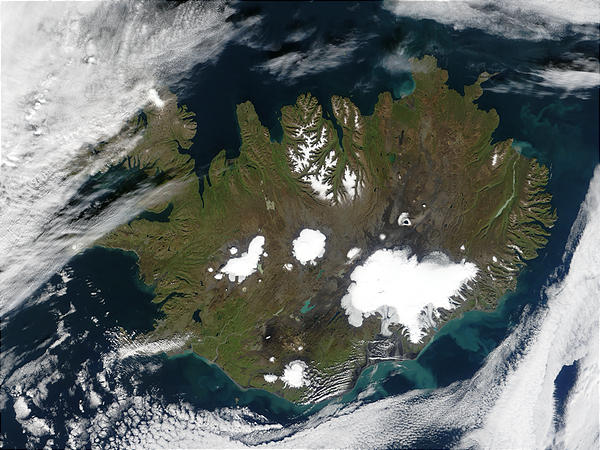Atlantic region near Iceland has cooled over the past 120 years. Image: NASA (public domain)
(German text translated by P. Gosselin)
There are areas of the world that stubbornly resist “global warming”. These include an oceanic region near Iceland where sea surface temperatures have cooled by almost 1°C in the last 120 years.
Allan & Allan 2019 have examined the “cold blob” more closely and suspect that the summer ice melt will cause cold melt water to flow into the ocean, which will then lead to the winter cold of the sea area.
The researchers disagree with the model by Stefan Rahmstorf from Potsdam, who suggested a weakening of the Gulf Stream as the cause of the “cold blob”.
Here’s the abstract of Allan & Allan 2019:
Seasonal Changes in the North Atlantic Cold Anomaly: The Influence of Cold Surface Waters From Coastal Greenland and Warming Trends Associated With Variations in Subarctic Sea Ice Cover
Worldwide sea surface temperatures (SST) have increased on average by about 1 °C since 1900 with the exception of a region of the North Atlantic subpolar gyre near 50°N which has cooled by up to 0.9 °C over the same period, generating the negative feature on temperature anomaly maps which has been colloquially described by Rahmstorf et al. (2015, https://doi.org/10.1038/nclimate2554) as the “cold blob” (abbreviated here CB). This unique long‐term surface cooling trend is most evident in February, but in August net warming is observed even at CB epicenter and the CB itself is reduced to a mere “warming hole.” These seasonal changes in the intensity of the CB are the product of two separate factors: (1) a long‐term winter cooling specific for the CB region which appears to be associated with cooling of Greenland coastal waters in autumn, plausibly linked to summer meltwater from icebergs and sea ice and (2) summer warming effects which derive from (a) dramatic reduction in summer sea ice cover in the sub‐Arctic over the last 30 years that allows enhanced absorption of sunlight by the new open water in summer and (b) an unusual period of increased summer sub‐Arctic ice cover in the early twentieth century, which lowers the SST baseline measured from 1900, thus increasing the calculated linear rate of change of SST with time. Both of these effects could contribute to the observed Arctic amplification of warming.”






Whatever. It’s still all caused by people driving SUVs and breathing and stuff.
As we are still living in an era with two frozen poles (one of the definitions of an iceage) it is quite possible that the interglacial era currently experienced is slowly running out of “steam”.
“suggested a weakening of the Gulf Stream”
Weakening of the Gulf Stream has been been happening for decades now.
Or not.
[…] etelänavan lämpenemistä. Pienestä alueesta siinäkin kaiketi kyse, niinkuin NTZ-sivuston uutisoimassa pohjoisen Atlantin kylmenemisessäkin (Linkki). Allan&Allan (2019) tutkielman tiivistelmä […]
And the cooling continues right up to today as was shown in the papers (Schweinsberg et al., 2019 and Kobashi et al., 2017) Kenneth Richard provided to this site on on 5th August 2019.
See links at https://notrickszone.com/2019/08/05/for-nearly-all-of-the-last-10000-years-greenland-ice-sheet-and-glacier-volume-was-smaller-than-today/ and note the temperature reconstruction they each show.
Same as it ever was …
here my personal website.
Article thanks
very informative .
Nice information. here my personal website.
Nice information,
thanks for sharing.
very interesting article.